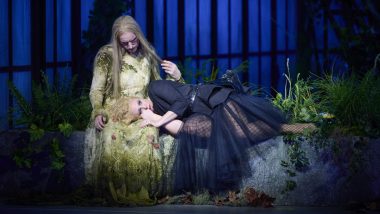 Sweden Jean-Philippe Rameau, Platée: Soloists of Gothenburg Opera, Gothenburg Opera Chorus, Gothenburg Opera Orchestra / Paul Agnew (conductor). Gothenburg Opera main stage, 20.3.2024. (NS)
Sweden Jean-Philippe Rameau, Platée: Soloists of Gothenburg Opera, Gothenburg Opera Chorus, Gothenburg Opera Orchestra / Paul Agnew (conductor). Gothenburg Opera main stage, 20.3.2024. (NS)

Production:
Director – Andreas Kriegenburg
Set design – Harald Thor
Costume design – Tanja Hofmann
Choreography – Sofia Nappi
Lighting design – Andreas Grüter
Cast:
Satyr / Cithéron – Kristian Lindroos
Thespis / Mercure – Wiktor Sundqvist
Thalie – Carolina Sandgren
Momus – Hannes Öberg
Amour / Clarine – Mia Karlsson
Platée – Anders J. Dahlin
Jupiter – Mattias Ermedahl
La folie – Sofie Asplund
Junon – Ann-Kristin Jones
Dancers – Ersin Arman Aycan, Barbro Carelius Hallgren, Julie Dariosecq, Heléne Friberg, Vadim Nuñez Belousov, Kerstin Höglund, Felix Skalberg, Bo Westerholm
Rameau’s Platée was a groundbreaking development as the first comic opera of the French baroque. The plot is a rehashed Greek myth satirizing an ugly swamp nymph who is deluded into thinking that Jupiter, king of the gods, wants to marry her. In Andreas Kriegenburg’s staging (sung in the original French) the emphasis is shifted towards a satire of a society obsessed with money and status over more important values like love and kindness.
In this production the action is moved to the present (or at least the twentieth century). The Prologue takes place in a 1950s Hollywood script factory where the scriptwriters have tried and failed to find inspiration in the bottom of wine bottles. Both Harald Thor’s set and Tanja Hofmann’s costumes oozed 1950s glamour and the entrance of the chorus (of secretaries) was delightful. The rest of the opera is set in the present day, where the multibillionaire Jupiter has on impulse bought a chateau in the south of France, thinking that making it a gift to his wife will help repair their marriage and fill some of the emptiness of his life.
The set for the first three acts is a beautiful, crumbling orangery tucked away in the park. Here Platée has made her home. The effect of the beautiful set is dreamlike, but Jupiter has thrown a housewarming party, and the well-dressed partygoers make a sharp contrast with the delicate, vegetable-toned clothes of Platée and the dancers who represent her memories and thoughts. The lighting was skillfully used to heighten the beauty of the setting and in changing mood and atmosphere.
Kristian Lindroos (Cithéron), Wiktor Sundqvist (Mercure) and Hannes Öberg (Momus) make an excellent ensemble as the three conspirators who devise the cruel plan for Jupiter to pretend to propose marriage to Platée in order to ‘cure’ Junon’s jealousy when she sees how old and weird Jupiter’s supposed bride is. Lindroos darkly colourful bass-baritone was always secure and worked well in his role as an amoral manipulator of Platée. Sundqvist by contrast had an elegant light tenor that was very appropriate for a heavenly messenger. Öberg’s Momus was a delightfully cheeky prankster but also hilariously the butt of a joke when he was forcibly undressed to impersonate Amour in his underpants, since the real Amour didn’t turn up to the fake wedding.
Mia Karlsson’s Amour had a sensationally beautiful soprano tone, rich in overtones, so it was a shame that she had almost nothing to sing after the Prologue. Ann-Kristin Jones (Junon) didn’t have much to sing either but made a strong impression with her mezzo-soprano convincingly expressive of more or less suppressed rage. Her acting when silently on stage observing the wedding preparations was also convincing. Jupiter was at least as much a target of the satire in this production as Platée herself, which Mattias Ermedahl handled with comic aplomb. His wordless acting when appearing to Platée first as a rabbit then as an owl (who didn’t appreciate being offered a dead mouse by Platée!) was hilarious. Ermedahl’s baritone was smooth and seductive.

We were treated to a sensational performance by Sofie Asplund as La folie, in all dimensions. Her first entrance was marvelously disruptive and followed by a magnificent aria whose soaring coloratura seemed effortless. Whenever she was on stage Asplund’s presence was magnetic. Much as La folie enjoys a party, she was touchingly sympathetic to Platée and they harmonized beautifully when singing together.
Anders J. Dahlin was a wonderful Platée, showing the fruits of his long experience as a haute contre tenor with a lovely tone and projection but also an impressive flexibility expression. Dahlin’s Platée had great dignity even if she was sometimes foolish and naïve. Platée’s elegant gestures felt like they came straight from the French theatre of Rameau’s time.
The Gothenburg Opera Chorus were wonderfully adaptable, convincingly singing as everything from frogs to drunk partygoers and perfectly executing Sofia Nappi’s demanding and impressive choreography. The seven dancers who accompanied Platée also had beautiful choreography and showed a wonderful attention to detail. The choice to have dancers with a wide range of ages worked wonderfully and meant that the choreography was focused on elegant movement rather than athleticism.
Rameau’s music was effervescent under Paul Agnew’s baton, both beautiful and bubbling like champagne. The Gothenburg Opera Orchestra’s playing was utterly beautiful and never sounded heavy despite using modern instruments. In the programme director Andreas Kriegenburg welcomed us to ‘a world of dreams and dignity’; for me the effect of the beautiful music and staging combined with a plot that moves slowly (especially before Act II) was dreamlike and quite different from most other operas. Kriegenburg’s production ends suggesting a question: who is more (morally) ugly: Platée, or the people who trick her and mock her?
Niklas Smith
Playing until 18 April 2024. The premiere was broadcast live on Swedish Radio and is available to stream until about 15 April on the Swedish Radio website (here) and the SR Play app. For tickets and more information see the Gothenburg Opera website (here).
